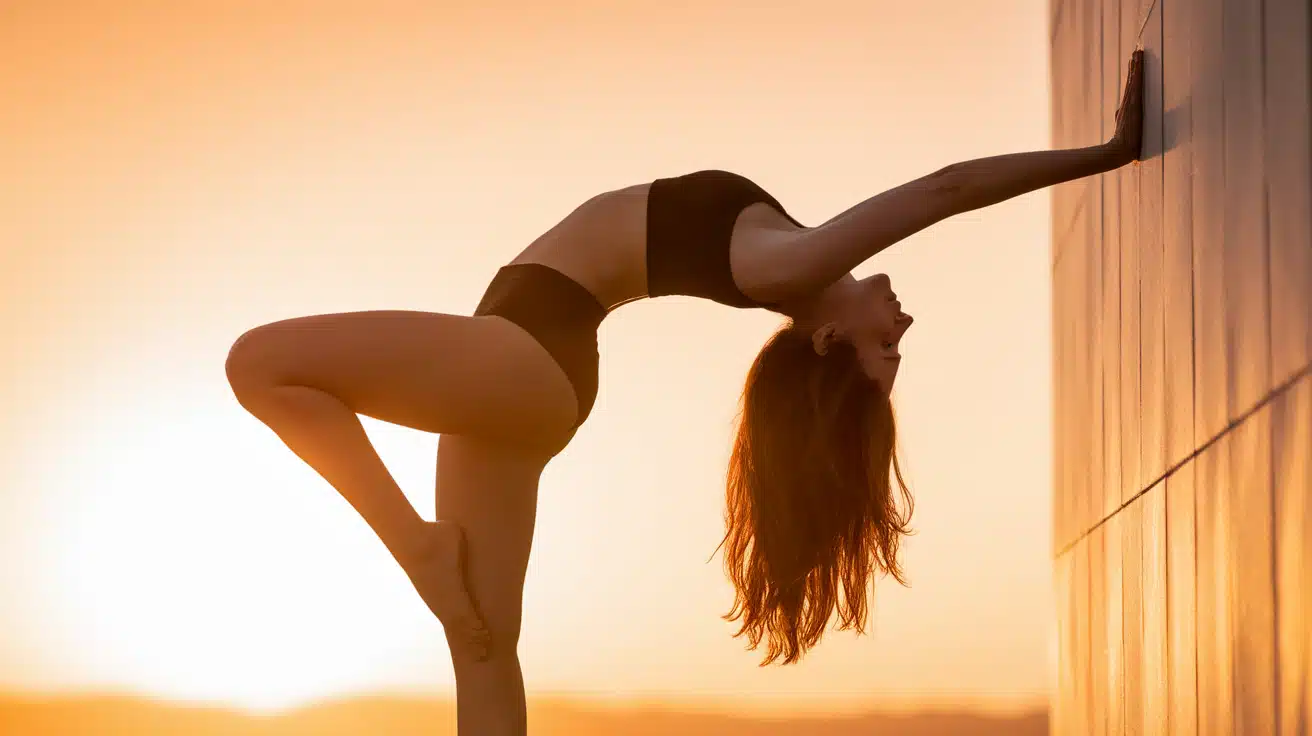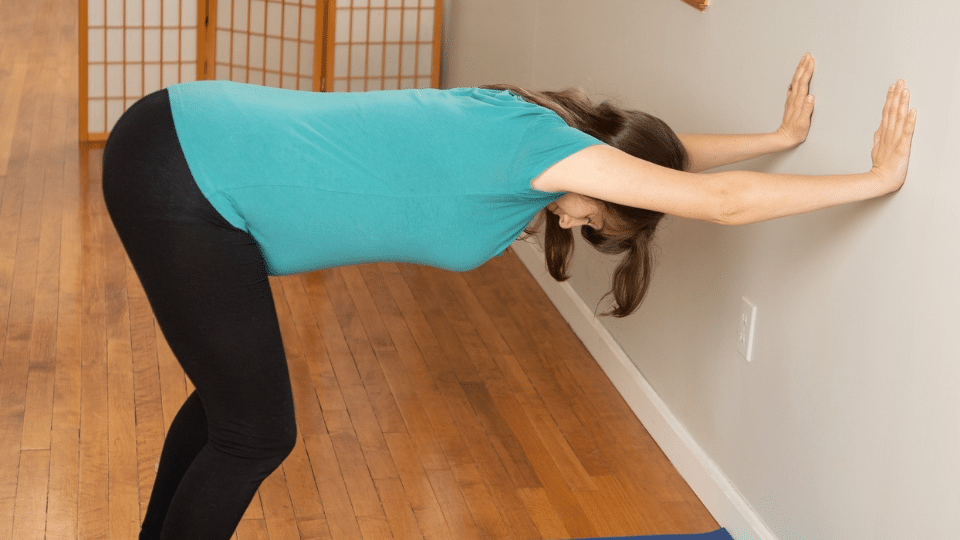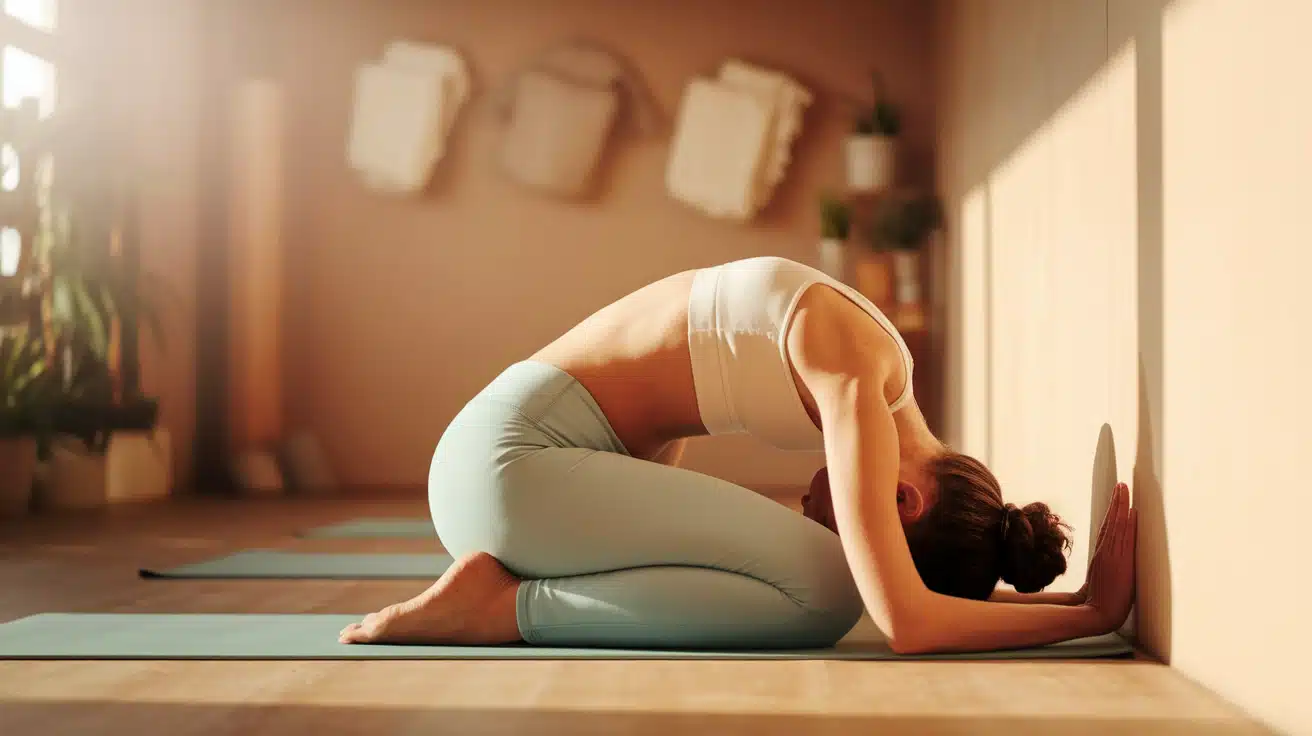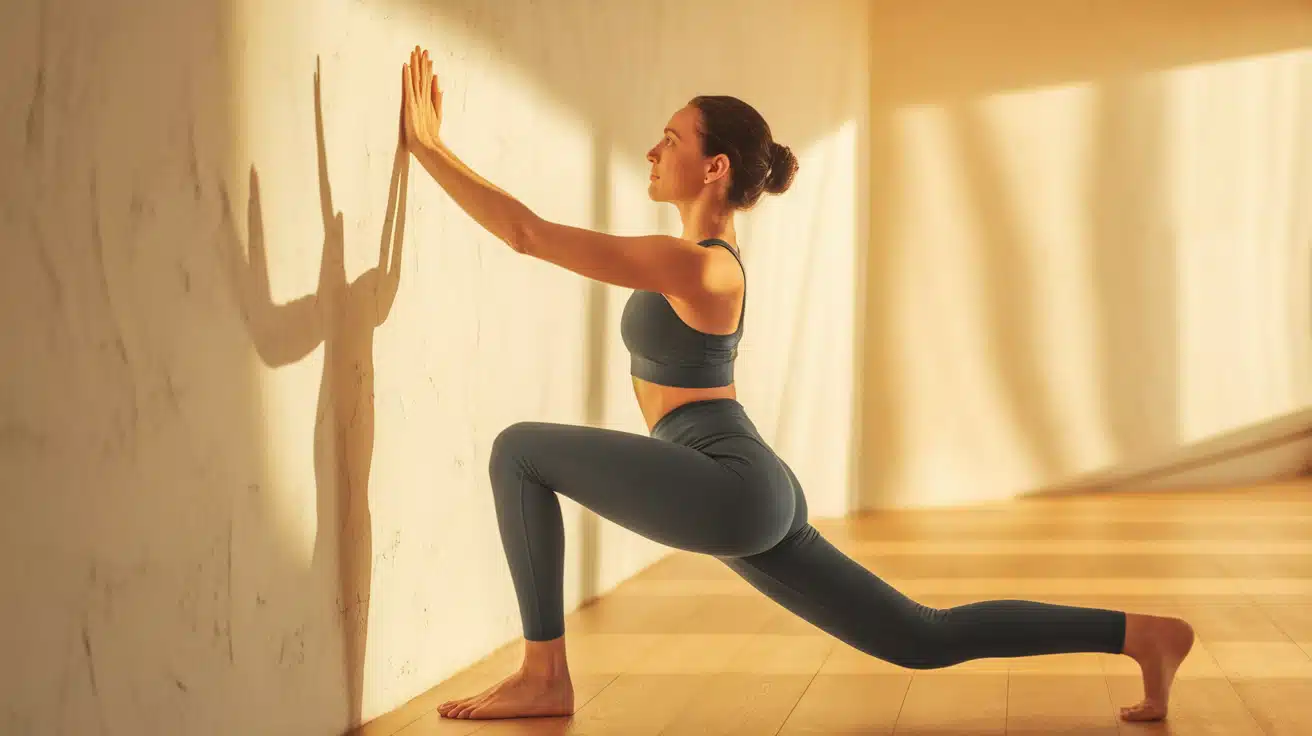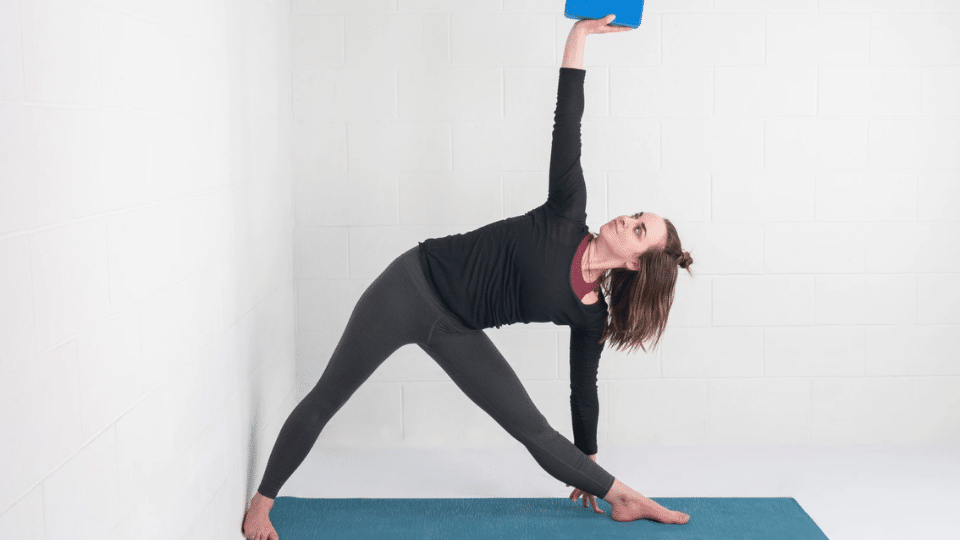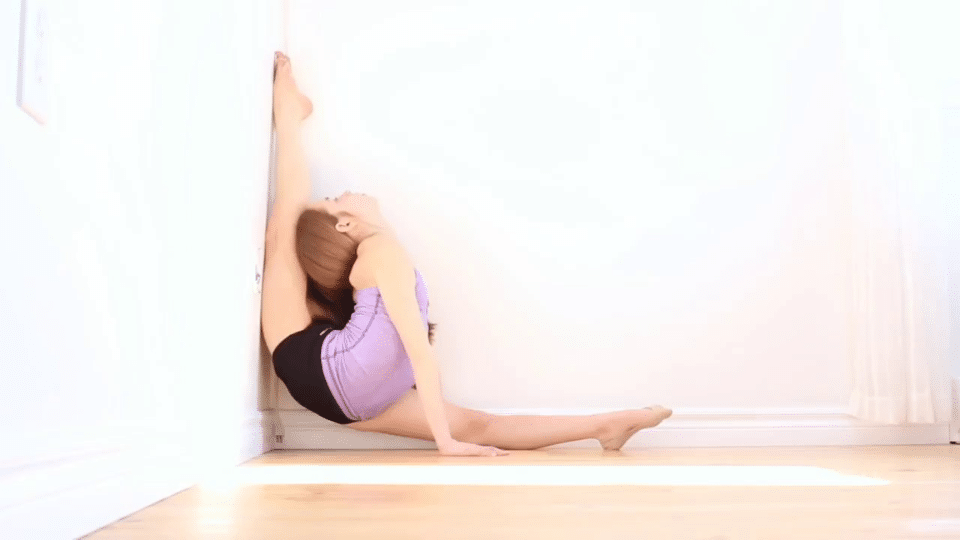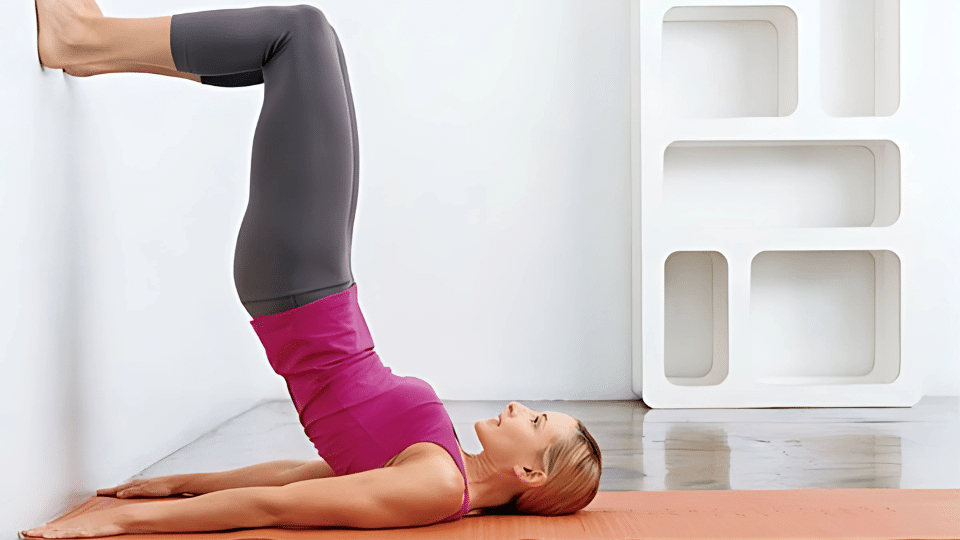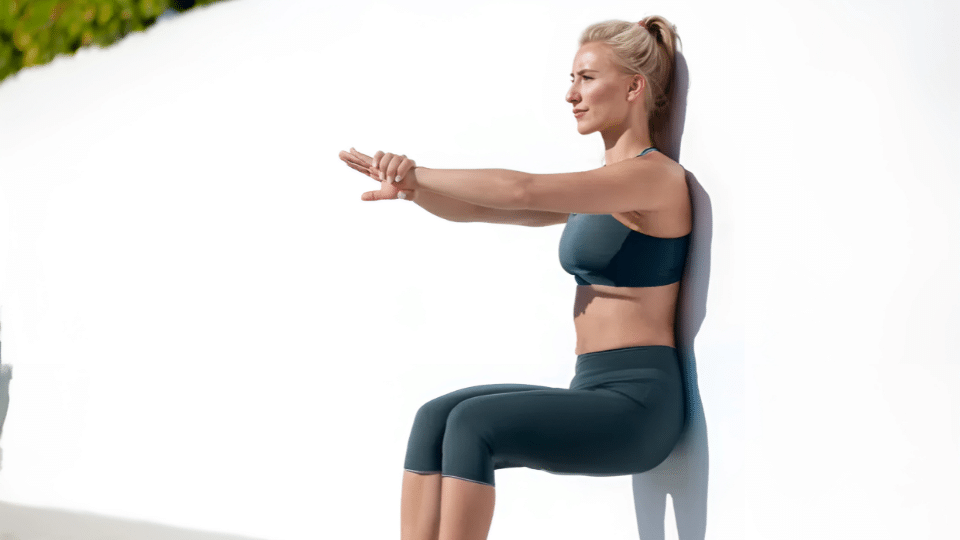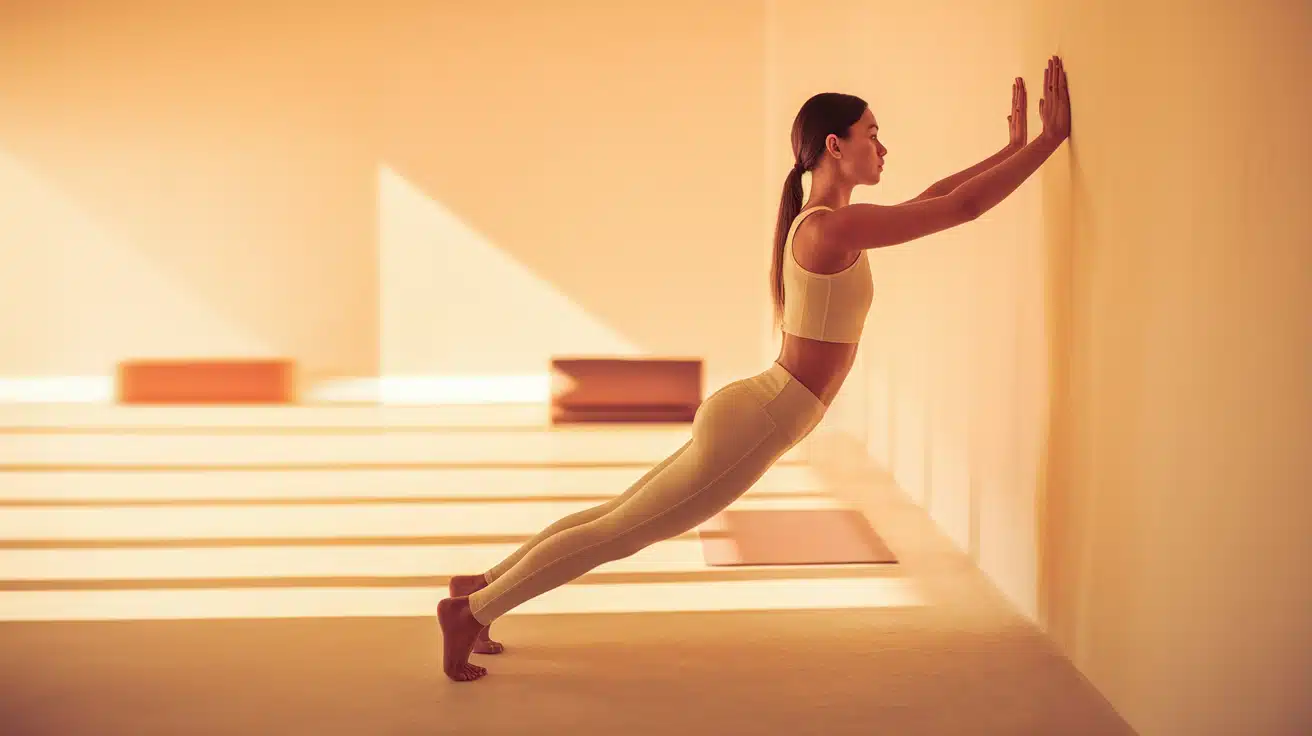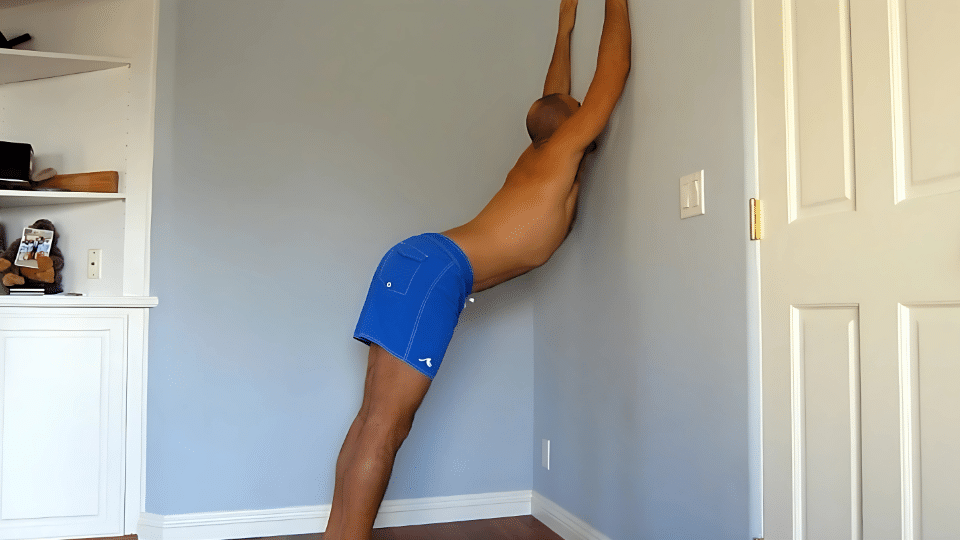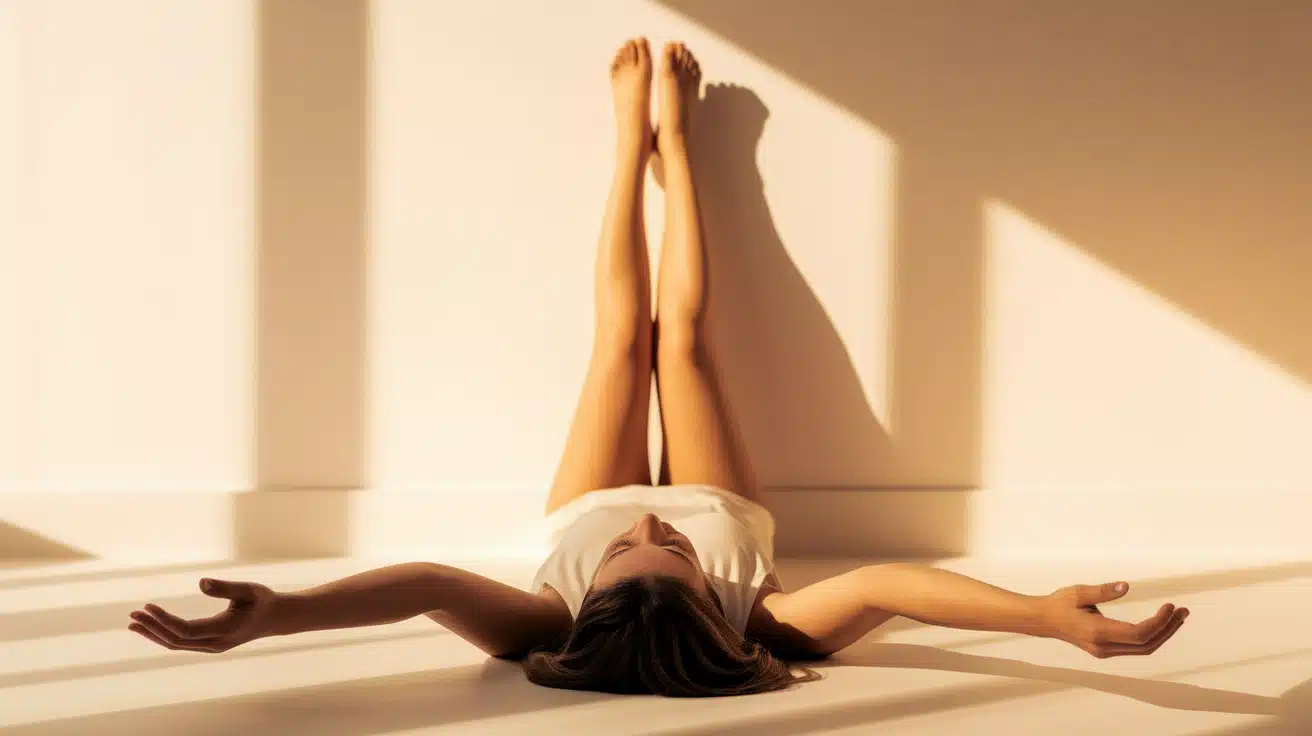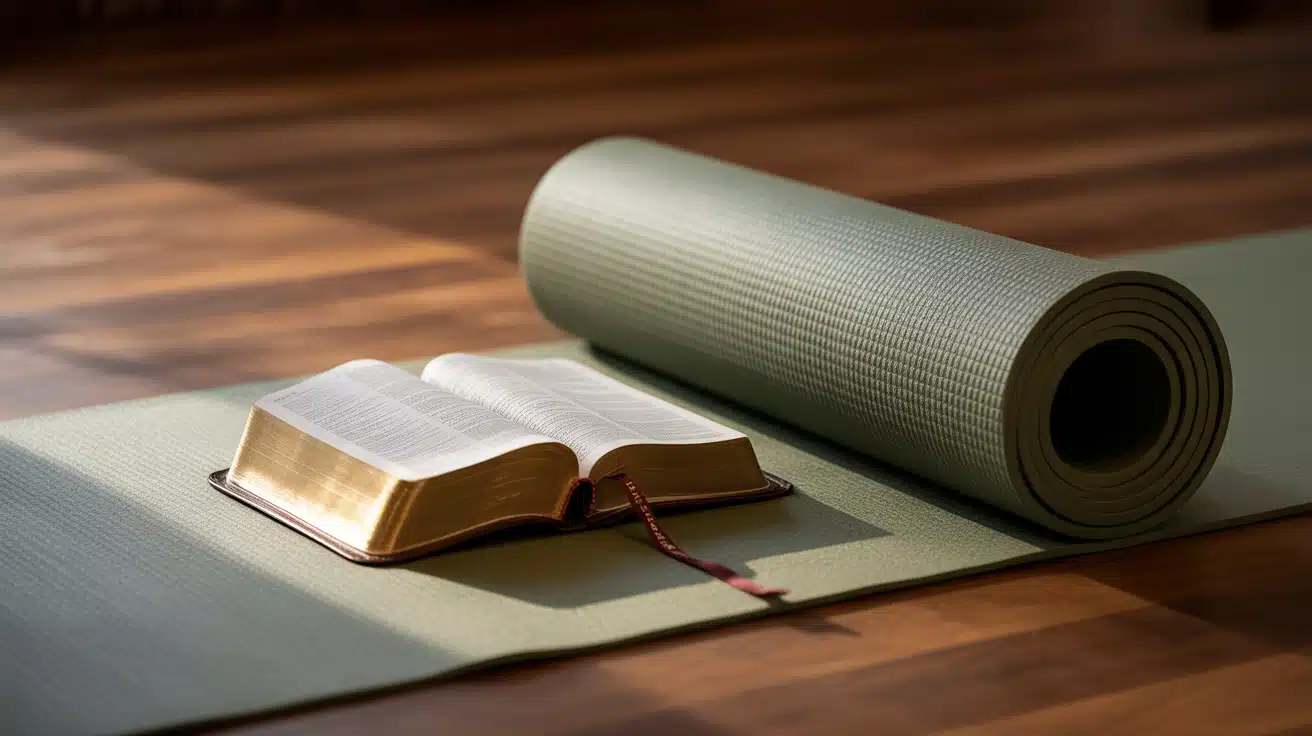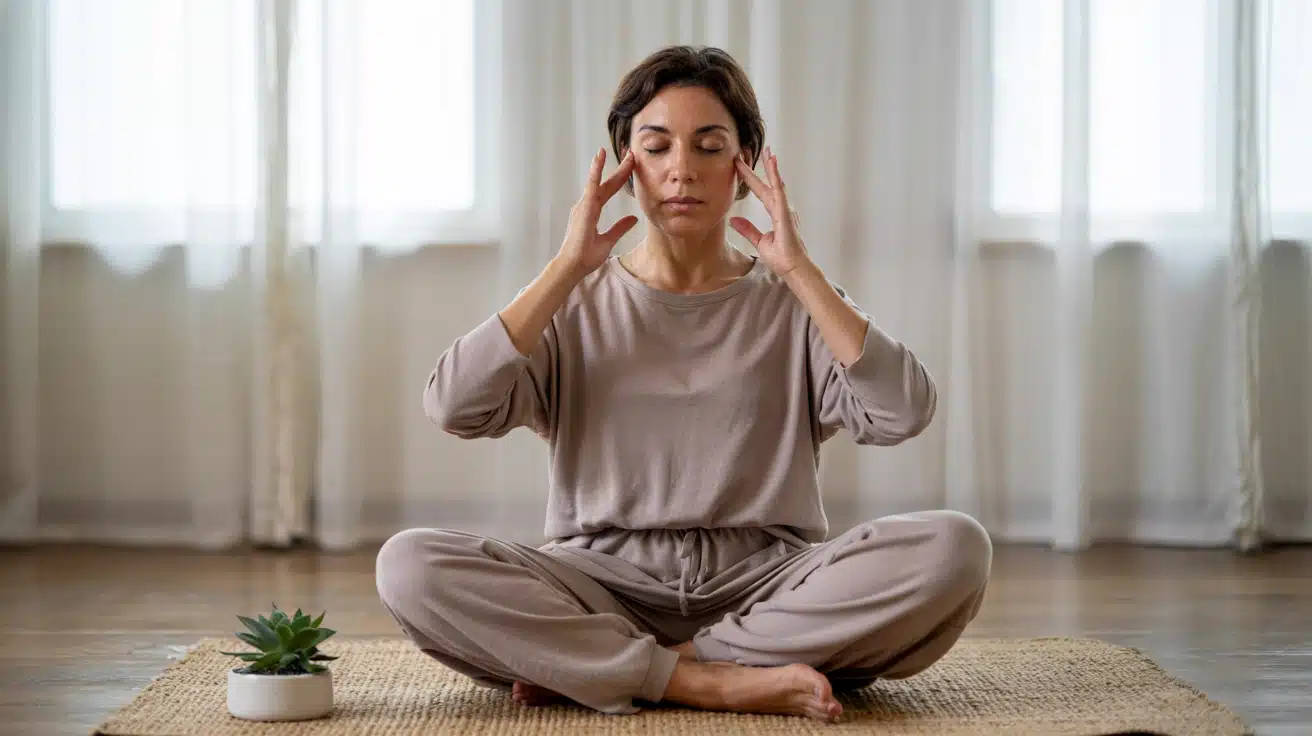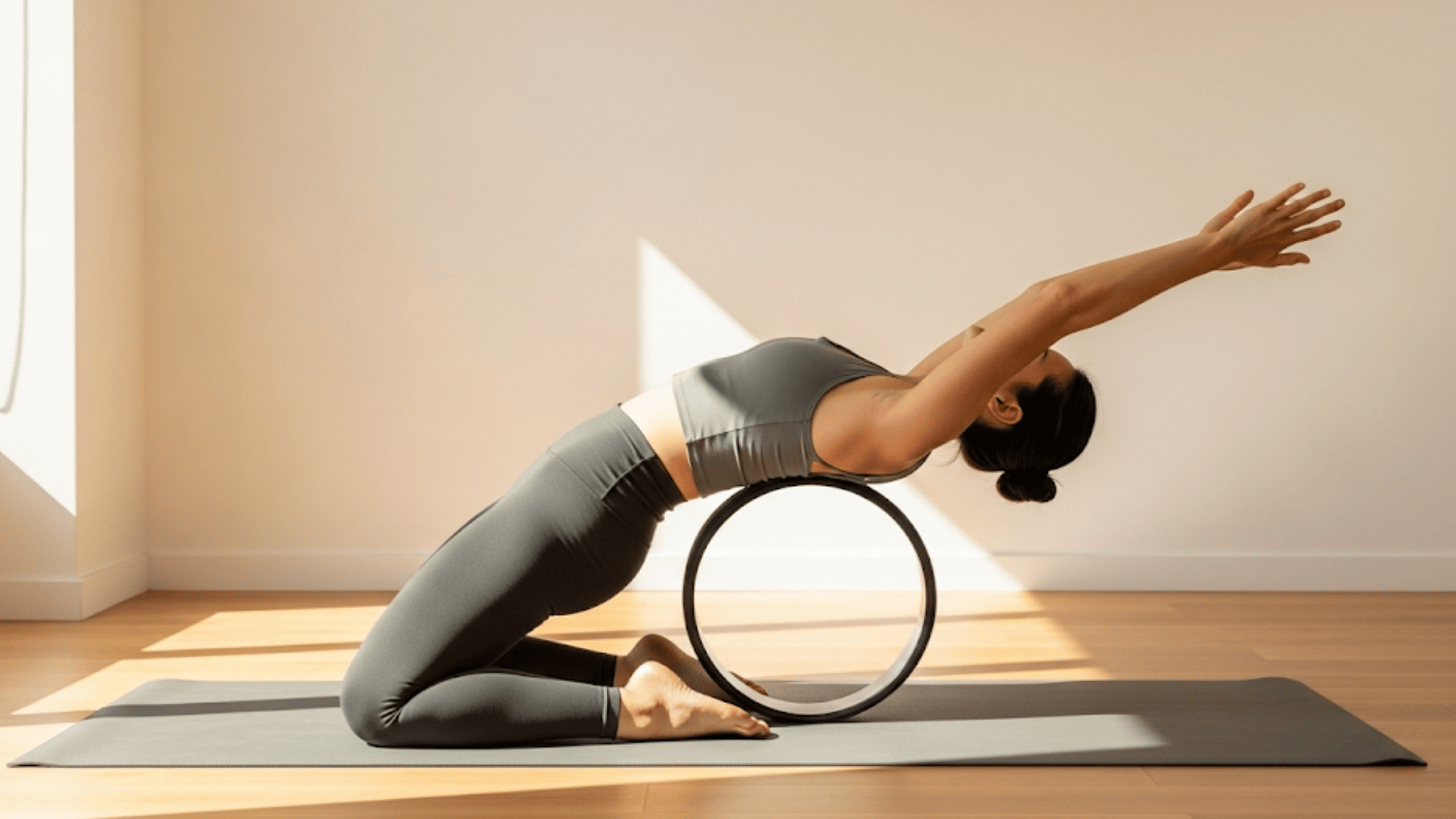Sitting at your desk all day leaves your body stiff and achy. Your shoulders hunch forward, your hips feel tight, and your back starts to hurt. Traditional yoga poses can seem too challenging or intimidating for beginners. You worry about falling or getting injured.
We promise that wall yoga is the perfect solution for your body’s needs. These supported poses use your wall as a helpful friend. You get all the benefits of yoga without the fear or strain.
You’ll learn instructions for each pose, targeted benefits for your specific problem areas, and how to build strength safely and effectively.
From legs up the wall for tired feet to wall planks for core strength, every pose supports your body while you stretch and strengthen.
Ready to feel better in just minutes?
What is Wall Yoga?
Wall yoga uses a wall as support during yoga poses. It makes yoga safer and easier for beginners. You can do stretches, strength moves, and relaxation poses against the wall.
This style helps you hold poses longer without strain. Wall yoga is ideal for individuals seeking additional stability in their practice.
The wall acts like a steady partner that never lets you fall. You can focus on proper form instead of worrying about balance. Office workers love wall yoga for quick desk breaks. Seniors find it gentle on joints while still providing significant benefits.
Benefits of Wall Yoga
- Improves alignment and posture – The wall helps keep your body in a proper position during poses.
- Enhances balance and flexibility – Wall support allows you to stretch deeper and hold poses more steadily.
- Provides support and stability – Perfect for beginners or those with balance issues.
- Reduces injury risk – The wall prevents you from falling or overstretching.
- Deepens body awareness – You can focus on form instead of worrying about balance.
13 Wall Yoga Poses for a Stronger & Flexible Body
Learn how to use your wall as a yoga prop to enhance alignment, deepen stretches, and build strength, perfect for beginners, seniors, and anyone seeking a gentle yet effective practice
1. Legs Up the Wall
A gentle inversion that rests your legs against the wall while lying on your back. This calming pose helps reduce leg swelling and stress. Perfect for evening relaxation or after long days on your feet.
Instructions:
- Lie on your back near the wall
- Extend both legs up the wall
- Rest your arms by your sides and breathe deeply for 5-15 minutes
Targeted Benefits: Reduces leg swelling, calms the nervous system, relieves tired feet.
2. Wall-Assisted Downward Dog
A supported version of downward dog using the wall to reduce wrist pressure. This pose gives you all the benefits of traditional downward dog without strain. Great for beginners or those with wrist issues.
Instructions:
- Stand arm’s length from the wall
- Place palms flat against the wall at shoulder height
- Walk your feet back, creating an L-shape with your body
Targeted Benefits: Stretches hamstrings and shoulders, builds upper body strength.
3. Wall Child’s Pose
A restorative pose that uses the wall for gentle forward fold support. This variation helps you stretch your spine while feeling completely supported. Ideal for stress relief and gentle back stretching.
Instructions:
- Kneel facing the wall about 2 feet away
- Sit back on your heels
- Place forearms against the wall and breathe deeply
Targeted Benefits: Relieves stress, stretches spine and shoulders, promotes relaxation.
4. Wall Lunge Stretch
A deep hip flexor stretch using the wall for balance and support. This pose helps open tight hips from sitting too much. Great for office workers and anyone with tight hip flexors.
Instructions:
- Stand facing away from the wall in a lunge position
- Place your back foot flat against the wall
- Lower into a lunge and hold for 30 seconds on each side
Targeted Benefits: Opens tight hip flexors, improves posture, strengthens legs.
5. Wall Shoulder Opener
A chest and shoulder stretch that uses the wall for leverage. This pose helps fix rounded shoulders from computer work. Perfect for opening tight chest muscles.
Instructions:
- Stand arm’s length from the wall
- Place your right palm flat against the wall at shoulder height
- Turn the body left and hold for 30 seconds each arm
Targeted Benefits: Relieves tight chest muscles, improves shoulder mobility, fixes rounded shoulders.
6. Wall Triangle Pose
A supported triangle pose using the wall for balance and alignment. This pose stretches your side body while keeping you stable. Great for beginners learning the triangle pose.
Instructions:
- Stand with your back against the wall, feet wide apart
- Turn the right foot out 90 degrees
- Reach the right hand toward the right foot and hold
Targeted Benefits: Stretches side body, strengthens legs, improves balance.
7. Wall Half Splits
A hamstring stretch that uses the wall for support and proper alignment. This pose helps prepare you for deeper forward folds and splits. Perfect for tight hamstrings from sitting or running.
Instructions:
- Stand facing the wall, step left foot back into a runner’s lunge
- Straighten front leg, keeping heel down
- Hold for 30 seconds on each leg
Targeted Benefits: Stretches hamstrings, improves flexibility, prepares for full splits.
8. Wall Bridge Pose
A supported backbend using the wall for foot placement and stability. This pose strengthens your glutes while opening your chest. Great alternative to the floor bridge pose.
Instructions:
- Lie on your back with feet on the wall, knees bent
- Press feet into the wall and lift hips up
- Hold for 30 seconds to 1 minute
Targeted Benefits: Strengthens glutes, opens chest, improves spinal mobility.
9. Wall Squat
A supported squat pose using the wall for back support and proper form. This pose helps you build leg strength safely. Perfect for learning correct squat alignment.
Instructions:
- Stand with your back against the wall, feet hip-width apart
- Walk feet forward about 12 inches
- Slide down the wall into a squat position
Targeted Benefits: Builds leg strength, improves squat form, strengthens core.
10. Wall Plank
An incline plank using the wall to reduce difficulty while building strength. This pose is easier than the floor plank but still effective. Great for beginners, building core strength.
Instructions:
- Stand arm’s length from the wall
- Place palms flat against the wall at shoulder height
- Step feet back until the body forms a straight line
Targeted Benefits: Builds core strength, improves posture, and is easier than the floor plank.
11. Wall Puppy Pose
A heart-opening stretch that uses the wall for arm support. This pose opens your chest and shoulders gently. Perfect for counteracting hunched shoulders from desk work.
Instructions:
- Kneel facing the wall about arm’s length away
- Place palms high on the wall, arms straight
- Lower chest toward the ground while keeping hips over knees
Targeted Benefits: Opens chest and shoulders, improves posture, relieves upper back tension.
12. Wall Standing Forward Bend
A supported forward fold using the wall for hand placement and stability. This pose stretches your hamstrings without putting pressure on your back. Great for tight hamstrings and calming the mind.
Instructions:
- Stand arm’s length from the wall
- Place palms flat against the wall at hip height
- Walk feet back and fold forward, creating a 90-degree angle
Targeted Benefits: Stretches the hamstrings and back, improves posture, and calms the mind.
13. Wall Savasana
A relaxation pose using the wall for leg support and comfort. This final rest pose helps you absorb all the benefits of your practice. Perfect for deep relaxation and stress relief.
Instructions:
- Lie on your back with legs up the wall
- Rest arms by sides, palms up
- Close your eyes and relax completely for 5-20 minutes
Targeted Benefits: Deep relaxation, reduces stress, improves sleep quality.
Safety Tips and Who Should Avoid Wall Yoga Poses
- When not to invert – Avoid inversions if you have high blood pressure, glaucoma, neck injuries, or are pregnant.
- Modifications for joint sensitivity – Keep knees slightly bent, use pillows for support, and avoid deep twists if you have back issues.
- The Importance of Listening to Your Body – Stop immediately if you feel pain, dizziness, or discomfort during any pose.
- Heart conditions – Consult your doctor before trying wall yoga if you have heart problems or take blood pressure medication.
- Recent injuries – Avoid wall yoga for 6-8 weeks after surgery or if you have fresh injuries.
- Pregnancy considerations – After the first trimester, avoid lying flat on your back for extended periods.
- Eye problems – Avoid inversion poses if you have a detached retina, severe glaucoma, or have recently undergone eye surgery.
- Start slowly – Begin with 2-3 poses and gradually add more as your body adapts.
Conclusion
Wall yoga offers all the benefits of traditional yoga, with added support and safety. These poses help improve your posture, reduce stress, and build strength without strain. You can practice anywhere with just a wall and a few minutes.
Your body deserves gentle care, especially after long days sitting or standing. Wall yoga meets you where you are right now, no need to be flexible or strong to start.
Why does this matter? Your daily aches and pains don’t have to control your life. Small movements against the wall can create significant changes in how you feel. Better posture, less tension, and improved mood are all within reach.
What’s next? Start with just one pose today. Try legs up the wall for 5 minutes tonight before bed. Notice how your body feels. Then add another pose tomorrow. Your wall is waiting to support your wellness path.
Which wall yoga pose will you try first?
Frequently Asked Questions
Is Wall Yoga Effective?
Yes, wall yoga provides the same benefits as regular yoga while being safer and more accessible for all fitness levels.
How to Do Wall Yoga for Beginners?
Start with simple poses, such as legs up the wall, and use the wall for support. Hold each pose for 30 seconds to 1 minute.
What Does Putting Your Feet Up on a Wall Do?
It reduces leg swelling, improves circulation, calms your nervous system, and relieves tired feet and lower back tension.
What Is the Name of the Wall Pose in Yoga?
The most popular wall pose is called “Legs Up the Wall” or “Viparita Karani” in Sanskrit.

